It’s live! Access exclusive 2025 live chat benchmarks & see how your team stacks up.
Get the dataIt’s live! Access exclusive 2025 live chat benchmarks & see how your team stacks up.
Get the dataThe gap between customer service in the public sector and the private sector is vast. The top-performing private sector in the US boasts a customer satisfaction score of 8.3 out of 10. In US government, this score languishes at 4.5.
The reasons for this gap are complicated and numerous. With checks and balances built into government systems, as well as necessary regulations, citizens are often forced to interact with many departments and people to accomplish what seems a simple and straightforward task.
All this makes providing the very best customer service in government no easy feat. Employees are often left frustrated as improving customer service in government is constantly met with roadblocks. However, even within this complex system, there are many ways for customer service in the public sector and in government can be improved to meet citizens’ high service expectations.
With effective digital channels and technologies now available, there are proven and effective strategies to improve customer service in government, and do so – securely, smoothly, and cost-effectively.
“On the one hand, there are rising public expectations and pressure to improve. On the other hand, there is an immense opportunity to adopt new approaches and technologies to accelerate the change.” – McKinsey and Company, The global case for customer experience in government
In this guide, we provide an understanding of government customer service expectations and how citizens want to interact in today’s digital-first world. We will also discuss how government can improve customer service while meeting today’s strict security standards, exploring new approaches and tools with real-world examples and best practices.
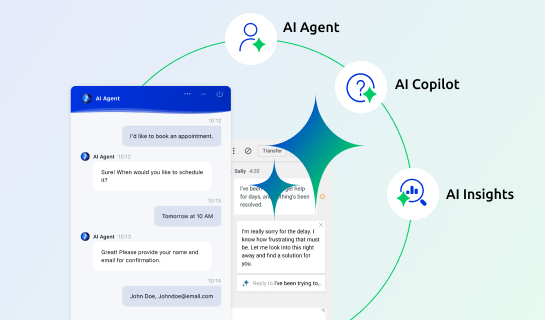
The New Comm100 AI Trifecta – Driving Smarter, Deeper Customer Relationships
Learn how AI Agent, AI Copilot, and AI Insights work together to transform CX.

Government agencies have long suffered from a notoriously poor CX image (in many cases from no fault of their own, but the result of complex and difficult systems). For many, the attempt to raise additional resources or divert existing resources to improve this has been met with resistance across the board. However, this is now beginning to change.
Around the world, government CX is being taken more seriously. With improved technology alongside new studies in behavioral science, governments are recognizing three major factors that are driving investment in CX:
Around the world, CX is becoming a core function of government. The United Kingdom’s Government Digital Services, the Canadian Digital Services, and Singapore’s Government Technology Agency are all examples of governments dedicating resources towards digital technologies that experience citizen experience, as well government employee experience. Even back in 2018, the Office of Management and Budget in the US ordered all executive branch agencies to add CX into their ‘strategic decisions, culture, and design of services.’
However, while this all points in the right direction, the quality of customer service in the public sector still has a long way to go, as we will see in the next chapter.

Technological advancements are benefiting businesses and consumers alike, but it’s also causing challenges for the public sector.
Today’s consumers are surrounded by the very best CX. A wealth of new tools and technologies are available to companies to help them deliver seamless CX and support. As these technologies become more readily accessible and available, consumers are becoming increasingly accustomed to these experiences. This is resulting in exceptionally high CX expectations, heaping pressure on the public sector to improve their often already lagging CX standards/offerings. As Granicus’ Chief Operating Officer Scott Macfee explained,
“Government agencies feel immense pressure to provide a seamless digital experience for citizens. As more people become accustomed to private sector delivery speed, integration of services, easy check outs and attentive customer service, a new normal of heightened expectations is firmly set in place.”
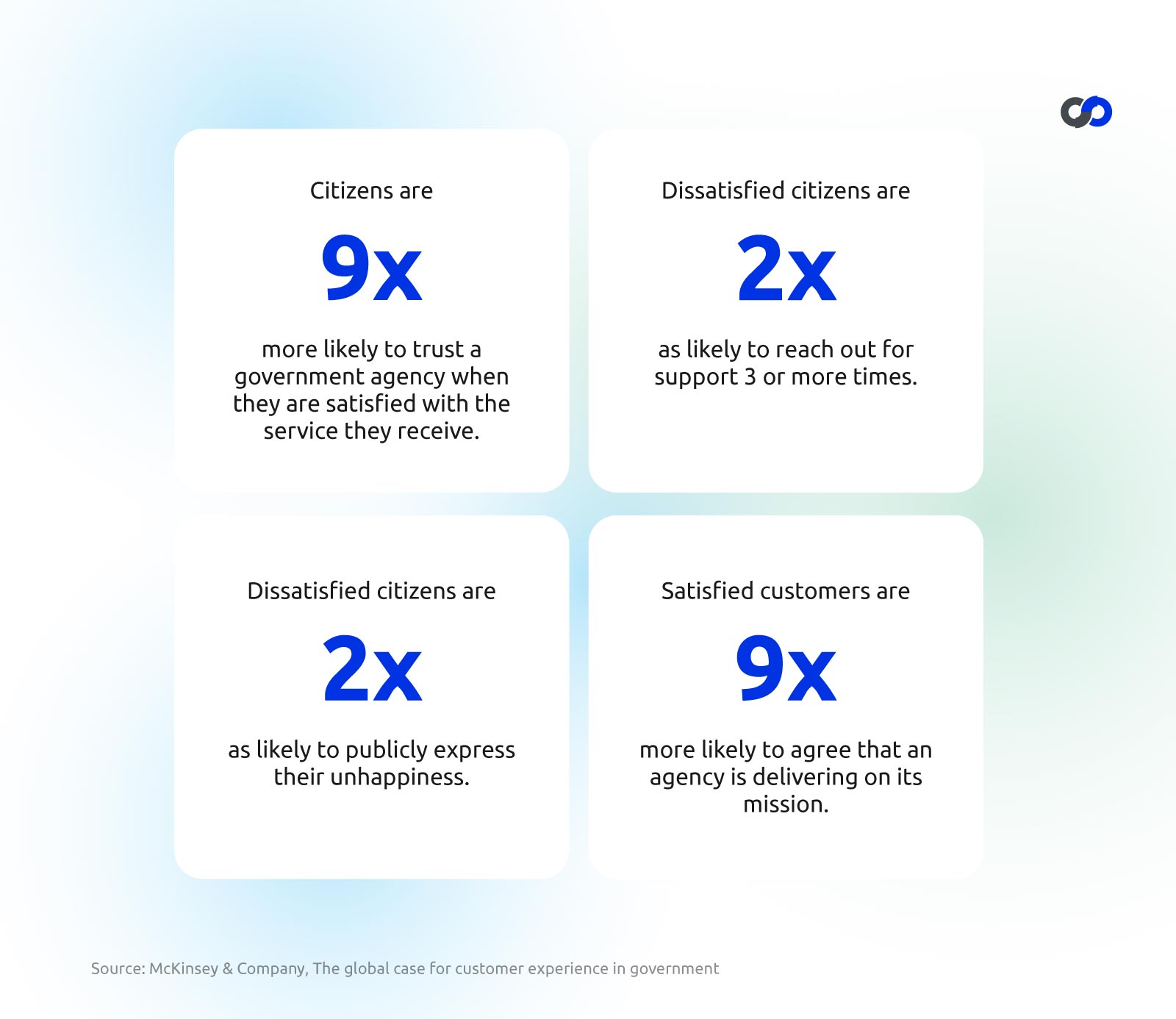
While many industries are adopting new technologies to meet these high customer service expectations, governments across the world are struggling to keep apace. In McKinsey and Company’s Public Sector Benchmark Survey, they surveyed more than 20,000 citizens across 140 government services in seven countries to understand if, and how much by, governments were falling behind private sector organizations in CX. The results spoke for themselves.
In each of the seven countries surveyed, government customer satisfaction (CSAT) score ranked last across every industry. In the US, while the top-performing industry enjoyed an 8.3 out of 10 CSAT score, government scored a disappointing 4.5. A similar picture appeared in Canada and the UK with country’s government agencies scoring a respective 5 and 4.8 out of 10.
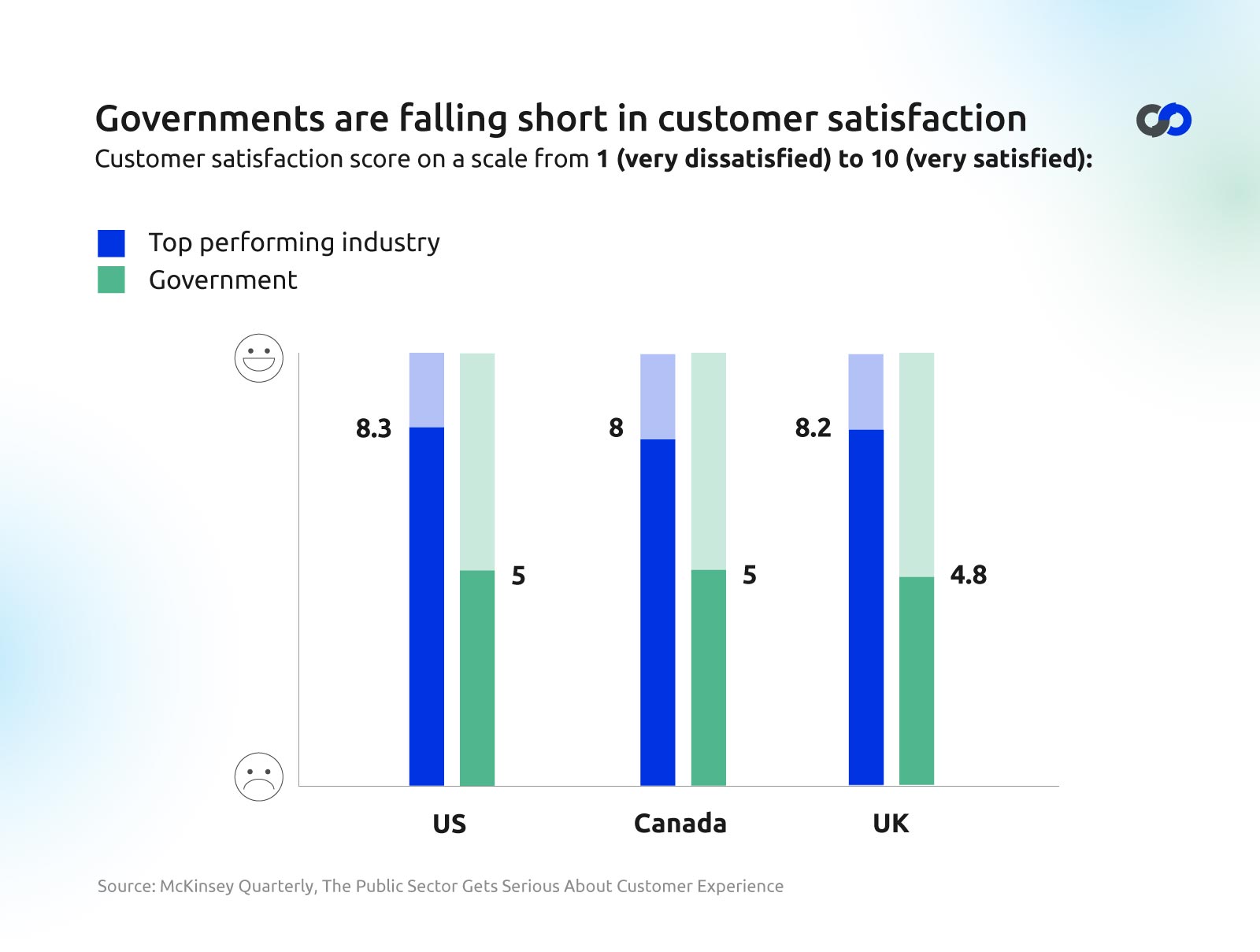
“Government agencies are in a bind. Citizens increasingly demand better digital experiences (DX), especially on mobile devices, but many existing sites are incapable of meeting those demands. With websites prone to crashing and data trapped in silos across agencies and departments, constituents are left underserved, discouraged and with waning trust in the public sector.” – Acquia, Transforming the UK Citizen Experience
The evidence that government agencies are struggling to meet their citizens’ support expectations is clear. In a survey by CFI Group, a global leader in citizen customer satisfaction measurements, only 68% of citizens said they were satisfied with the service they recently received from government contact centers. When asked if the transaction took a ‘reasonable time to resolve’, just 62% agreed.
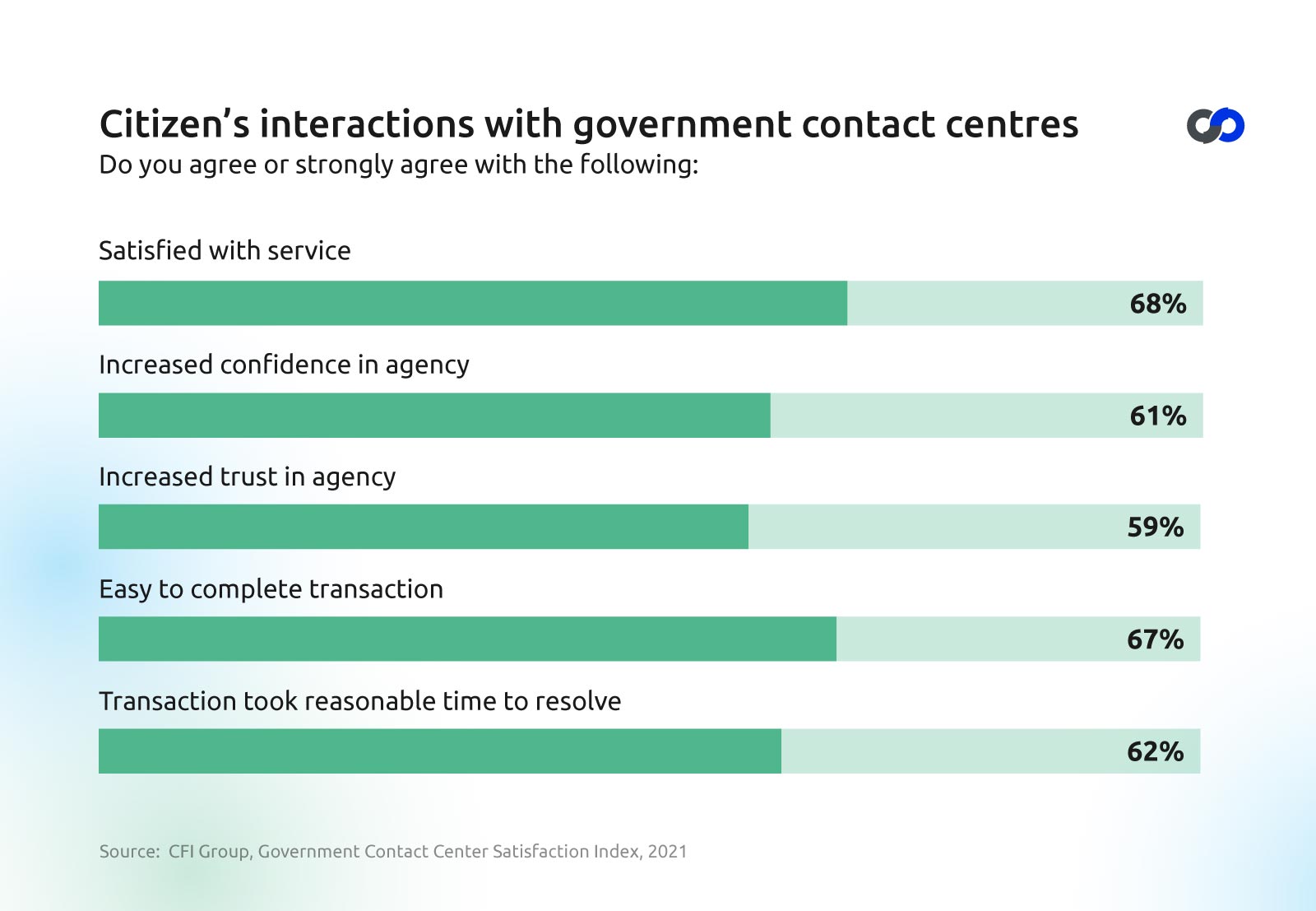

A private-sector company can determine their target audience and deliver an experience that they know they expect or need. However, for local government and government agencies it’s not so simple. Their role is to serve everyone within their jurisdiction across every demographic. Because of this, agencies are often forced to resort to a ‘one-size-fits-all’ service in an attempt to cater to their diverse citizen base.
However, while this may be true, there are several fundamental customer service expectations that all consumers want when they communicate with customer service reps. Here are the top 4 customer service expectations that every government agency should be, and can be, providing to improve customer service in the public sector:
Across every age demographic there is a move away from traditional support channels, particularly, phone, in favor of digital communication.
Telephone support has not become redundant by any means – many older and less digitally-able citizens still feel more comfortable with calling in rather than reaching out via live chat or social media. However, this tide is changing, and even faster now due to the Covid-19 pandemic. Across all ages, 74% of consumers say that they ‘expect to spend more time online after the pandemic than I did before’, while 80% agree that ‘Covid-19 has elevated my expectations of companies’ digital capabilities’. Even 59% of Baby Boomers (57-75 year old’s) agree with the latter.
For younger citizens, this demand for digital support is even stronger. 81% of people aged 10 to 41 admit that they often experience anxiety when talking to someone on the phone, while 60% of Gen Z say they simply ‘hate calling people’. In contrast to the unpopularity of telephone, 73% of customers find live chat the most satisfactory communication channel. Here are the key reasons for its popularity, among them speed, personalization and convenience.
As younger citizens lean heavily towards a digital-only preference and older citizens now prefer a combination of digital and telephone interactions, it’s vital for government agencies to offer digital communication channels that meet their expectations.
Learn how WCB Manitoba adopted Comm100 Live Chat to improve customer satisfaction and resolution in the video below:
There are many factors that citizens look for in public sector customer service, but none more so across all demographics than simplicity. In McKinsey’s report, ‘The global case for customer experience in government’, they found:
“Across the majority of countries and services, simplicity and reliability are the most critical drivers of service satisfaction. In their interactions with government agencies, customers want experiences to be easy…”
Citizens of all ages and digital literacy want simple and easy customer service above all else. This means simplicity across each stage, from accessing help via their chosen channel, to receiving clear guidance from a customer service rep. As Apple wrote in the headline of their very first marketing brochure – “Simplicity is the ultimate sophistication”.
This desire for simplicity is underpinned by a behavioral psychology known as the Simplicity Theory. This theory explains that people have a bias towards simplicity and ‘are predisposed to choose products and experiences that minimize their cognitive load… In other words, people don’t want to think too hard about your customer experience because thinking is hard work. They’d rather just avoid an experience altogether if it means less thinking is involved.’
All government websites and services must be accessible to its citizens. Under some governments, this means removing any barriers that prevent participation by persons with an impairment. These impairments could include impaired vision, deafness or impaired hearing, motor difficulties, and cognitive disabilities.
With these acts now commonplace, customer service in government and the wider public sector must meet these accessibility requirements. Live chat software can with WCAG compliance, inbuilt audio and video chat, auto-translation and customizable buttons and text.
When citizens reach out to customer service in the public sector, they do so primarily because they need information. It’s therefore essential that the information given is up-to-date and accurate so their issue can be resolved – and importantly resolved on first point of contact. First-point-of-call-resolution helps to retain customers, turns dissatisfied customers into satisfied ones, and maximizes agent productivity.
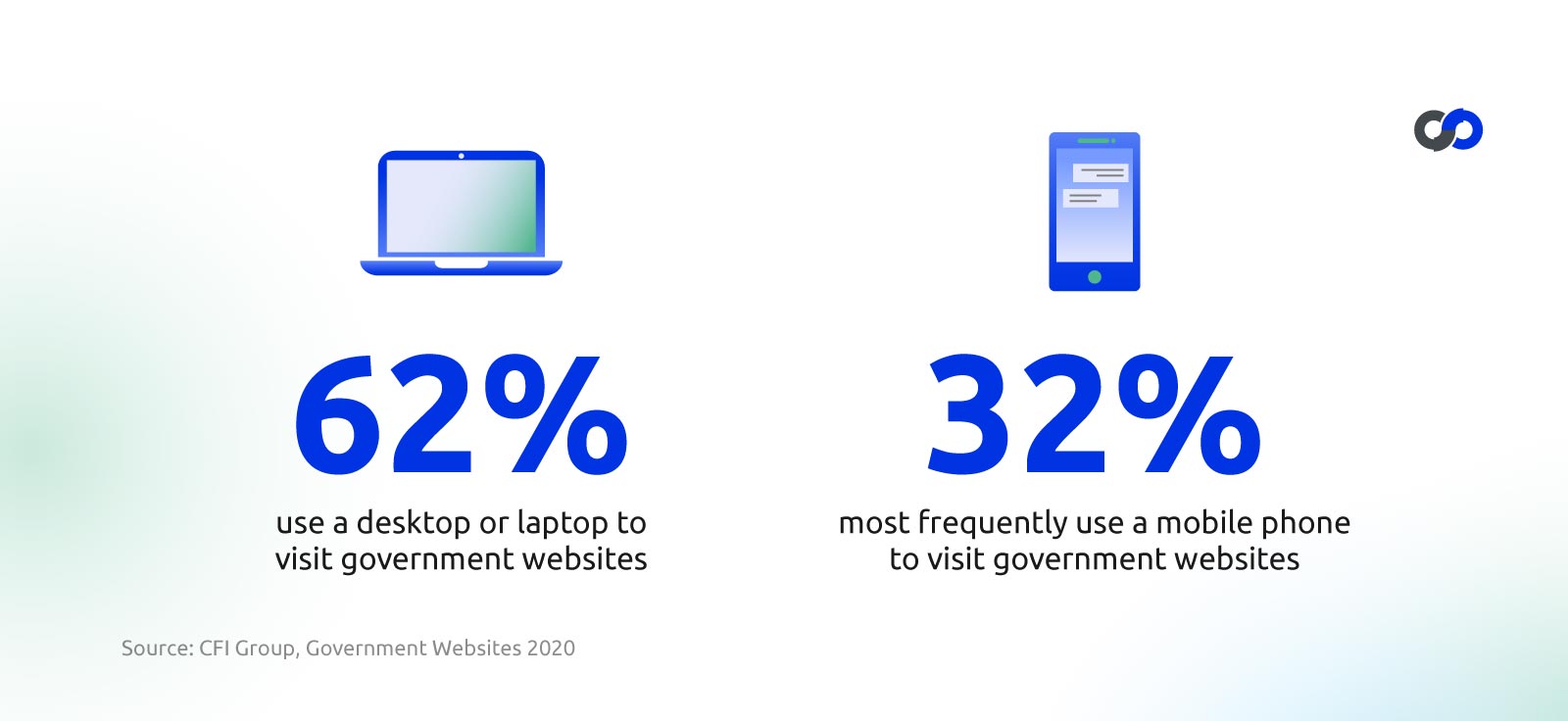

There are many challenges and roadblocks that make improving customer service in government no easy task. However, we have listed the top five steps that every government agency, local government, and public sector organization can employ to improve citizen support and satisfaction.
As we’ve spoke about earlier in this guide, there is a clear movement towards digitalization among all ages, accelerated by Covid-19. In a 2021 survey, 74% of consumers said they ‘expect to spend more time online after the pandemic than I did before’. As this demand for digital continues to grow, it is increasingly seeping into customer service as consumers move away from traditional phone support and towards digital support channels. 88% of US citizens now expect to interact with federal, state, and local government digitally.
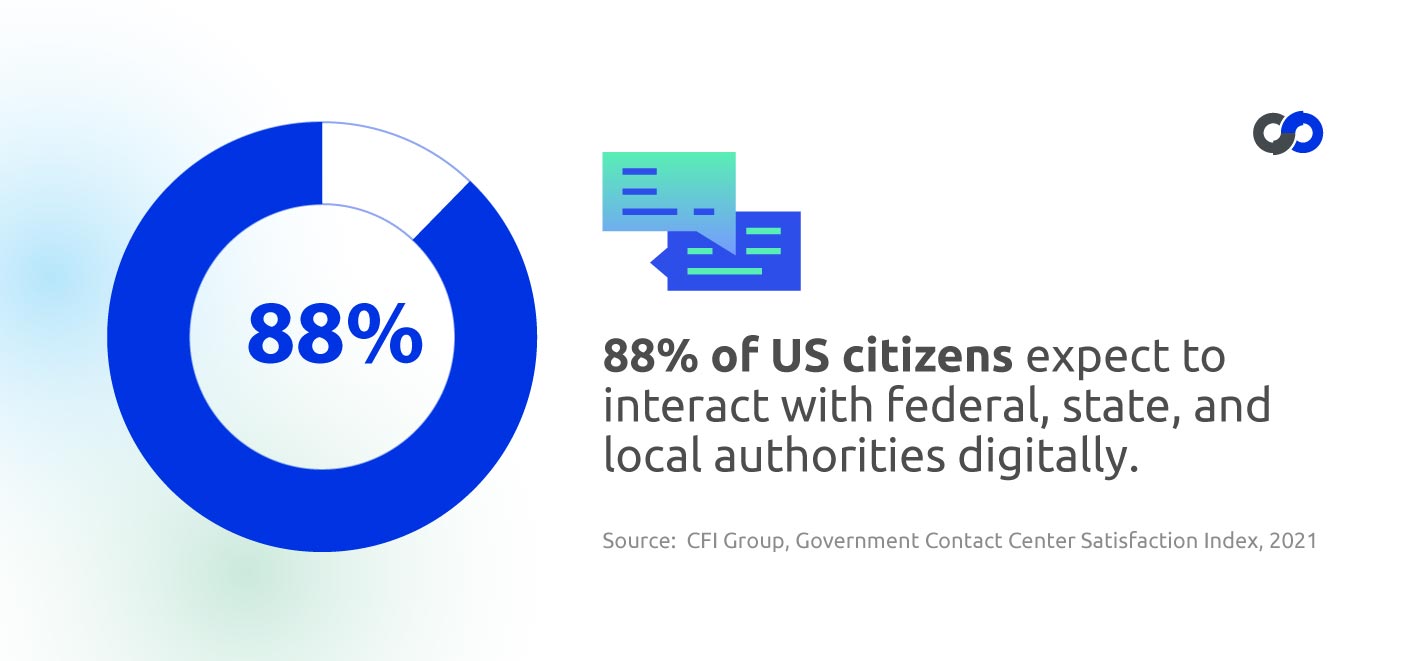
When it comes to digital support, there are two channels that are now essential for successful customer service in government – email and live chat.
Email has long been an integral channel for customer service in government agencies, often in the form of a webform. It’s an effective medium for citizens who don’t need immediate support or response and are happy to wait a number of days. With sophisticated help desk software, government agencies can track tickets from first call to resolution, ensuring nothing slips through the cracks.
However, for those citizens who want an answer faster than this but are put off from the prospect of long wait times and frustrating IVR that are often associated with telephone support, government live chat software is the answer.
Live chat is the most popular digital channel – 73% of consumers agree that live chat is the most satisfactory way to communicate with a company (and 51% for email). Its popularity largely stems from its convenience and speed. Sitting typically in the bottom right-hand corner of a website, users can easily connect with a customer service agent and receive an immediate answer through real-time messaging.
In a recent survey by CFI Group, they found that visitors who used live chat on government websites scored a 90% customer satisfaction index, compared to a 71% score for visitors who didn’t use live chat. Despite this, only 12% of government websites are reportedly using live chat. If you want to improve your customer service operations, take a look at this shopping checklist to find the best live chat in government.
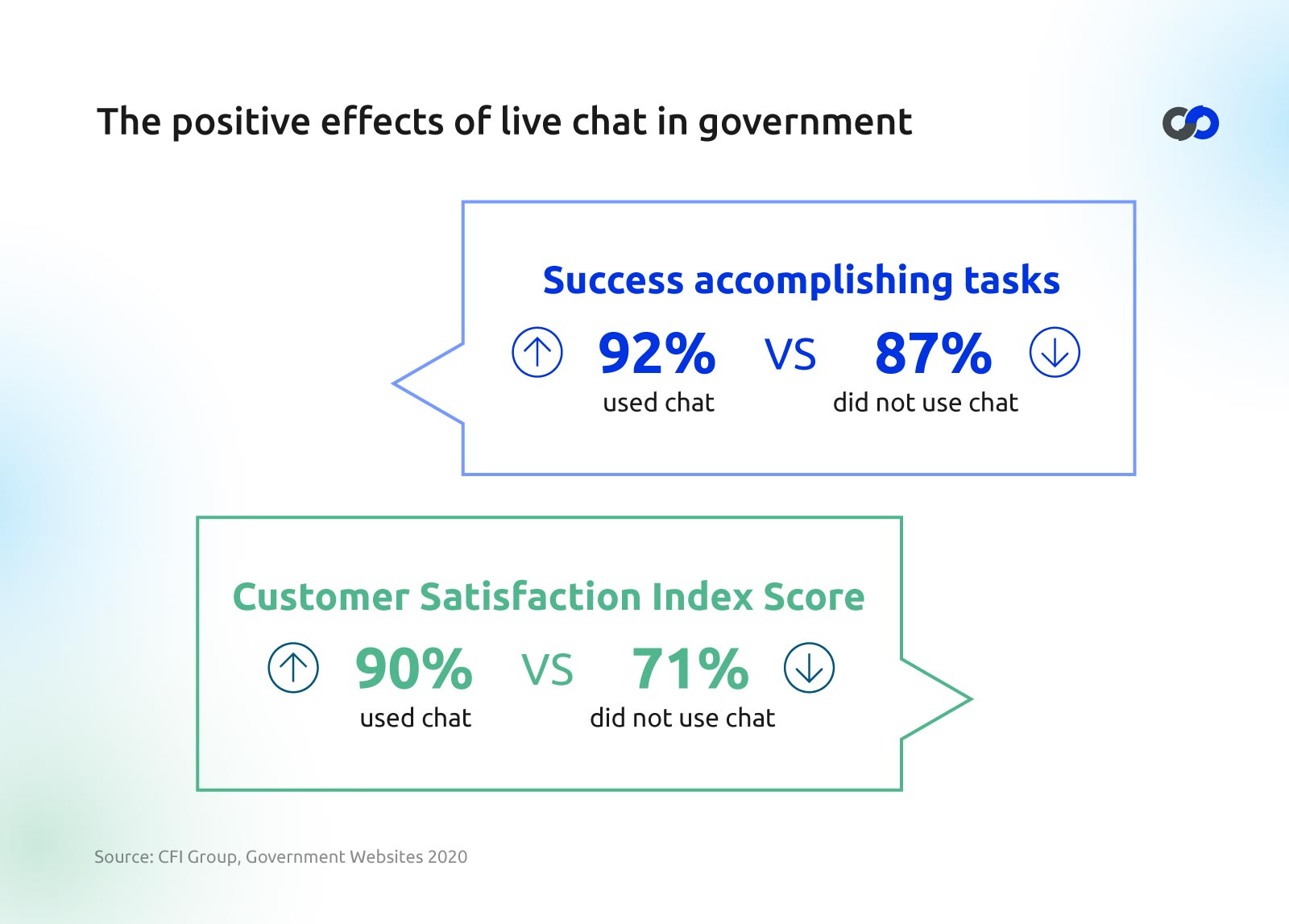
Santa Fe County has been using Comm100 Live Chat since 2018. It’s Assessor’s Office deals with large amounts of often complex information. They found that their citizens were often struggling to find answers to their questions and relying on already busy phone lines for more support. Realizing the long wait times and negative CSAT that this was causing, Santa Fe County launched live chat. Now, these citizens now receive fast and accurate support, improved also by live chat’s ability to route each chat query to the most appropriate agent or department. Learn the full story in the video below:
If you’re considering implementing live chat, read this government live chat shopping checklist to make sure you pick the best provider for your needs.
It perhaps should not come as a surprise to hear that 49% of citizens in 2020 visited a public sector website outside of regular business hours. For these visitors, most typically searching for information or needing support, there is no access to support past 5pm. This has long been considered an unfortunate but unavoidable circumstance – government agencies and local government simply don’t have the resources to offer 24/7 customer service. However, chatbots in government are now changing this.
There are two major chatbot technologies that governments can use to provide around-the-clock support to their citizens – task bots and AI chatbots:
1) Task bots
A task bot is an interactive bot that resolves common customer service and support questions. Sitting within the live chat window, a task bot guides visitors through a series of questions and answers to help resolve their query. They can also help them complete simple actions like scheduling a meeting or registering for an event. Better still, task bots are incredibly easy to build, requiring no coding or programming – simply choose from a selection of templates or build your own with an intuitive drag-and-drop functionality.
2) AI chatbots
In contrast to task bots, AI chatbots are powered by artificial intelligence. This means that rather than following a pre-set range of questions, AI chatbots can understand intent and complexities of language, allowing them to engage in more natural conversations. This allows them to handle more questions, all without any human interaction, so government agencies can provide 24/7 support without the unattainable cost of night-time agents.
‘69% of consumers prefer to use chatbots than speak with an agent. The key reason for this is simple. Above all else, consumers want fast answers to their questions. They don’t mind if they are being served by a chatbot or an agent – so long as their issue is resolved quickly.’ – Why are Top Brands Embracing AI Chatbots?, Comm100
For more reasons why you should adopt bots, take a look at the top benefits of local government chatbots and why bots are becoming a key local government customer service strategy.
The main reason why citizens visit government websites is to find information. Many will do so to avoid notoriously frustrating IVR systems and long wait times on the phone. In fact, 79% of visitors try to resolve their issue before contacting customer service, primarily turning to the agency’s site to do so. This form of self-service, often in the form of a knowledge base, is beneficial for any public sector organization as the more people who resolve their problem without contacting customer service, the better. However, this can only be achieved if the information provided is always up-to-date, accurate, and easily findable.
In a study by CFI Group analyzing government websites, visitors gave a score of only 72 out of 100 for the websites’ navigation – ‘intuitive navigation that allows a visitor to easily find what the need’. Search was given 73 out of 100, and content only 77.
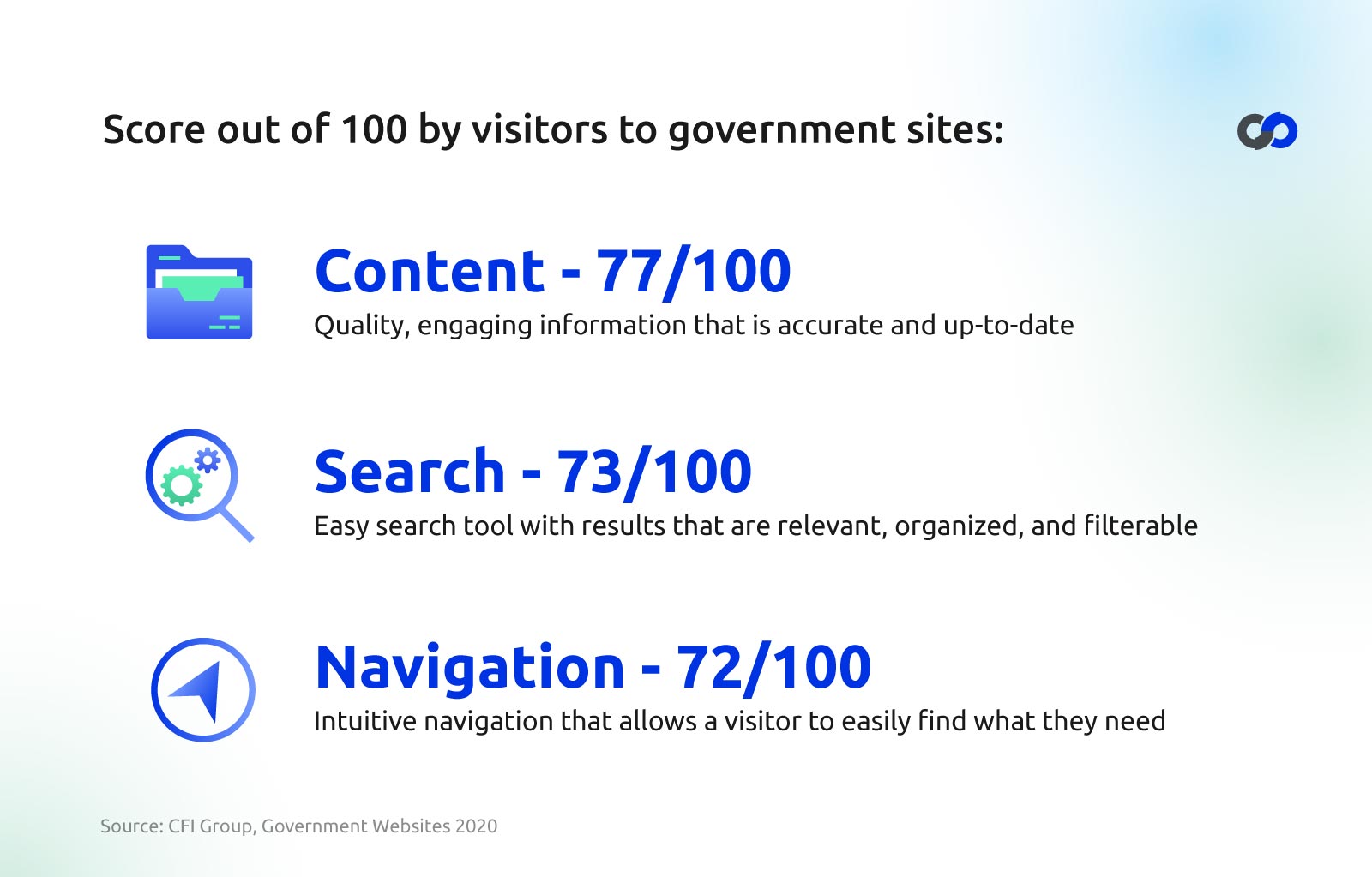
To improve these figures, a key local government customer service strategy should be to implement knowledge base software. This immediately enables organizations to provide up-to-date and easily searchable information. With a robust knowledge management system in place, content can be easily managed, presented and accessed – both externally for citizens, as well as internally for agents.
“Agencies need the ability to update digital content in minutes, providing information that is relevant to the present hour. Editing, removing and replacing content needs to be simple and intuitive. Agencies must be able to orchestrate messages in real time across all communication channels, including email, social, SMS/push and direct mail.” – McKinsey & Company, The global case for customer experience in government
When it comes to security and privacy, government doesn’t have an easy ride. As Acquia explains in its report, ‘From Customer Experience to Citizen Experience’:
“The demand on IT to deliver trusted, non-intrusive and scalable service is stringent and it’s much easier said than done. Coupled with the fact that most public sector IT groups need to factor in many legacy solutions and technologies, the job may seem impossible at times.”
Pressure for tight security and privacy is also being driven from the public – 99% of customers believe companies need to improve their trustworthiness, and 83% ‘wish there were stronger consumer data privacy laws in my country’.
With this in mind, public sector customer service must ensure that any communication with citizens follows the most stringent compliance standards and certifications. Convenience and speed of government services simply cannot be prioritized over data security.
Live chat helps to alleviate these concerns. Live chat software like Comm100’s complies with all major international security standards and privacy laws that government agencies need including:
For organizations bound by laws regulating the transmission and storage of data within a specified geographic region, on-premise deployment of live chat proves may also be a necessity. Comm100’s on-premise deployment of live chat for government allows organizations to host and maintain their own live chat, using their own hardware, and maintaining full custody of data storage.
As with any sector or organization, the more insight you can gain about your consumers, the better equipped you are to deliver the customer experience (CX) that they want. While government agencies employ a range of strategies to collect data about their citizens, data that can be collected through customer service interactions is often overlooked.
By using an omnichannel customer service platform, government agencies can connect every communication channel (and the data within) together within one platform. With all this information collated, they have access to a wealth of data about their citizens, providing them with a cohesive and accurate image of what their citizens are searching for, needing help with, and are thinking. As well as a key local government customer service strategy, this information can also be used as part of their efforts to map the customer journey.
When Santa Fe County launched Comm100 Live Chat, they soon recognized the value of the data that they could collect and analyze with the Comm100 platform:
“Getting access to all the data that comes through Comm1000’s platform is gold. We present a lot of this data to our administration to show them what our constituents are asking for, what they need, and how they feel… We read through chat transcripts, which is a great training tool too.” – Santa Fe County, Tommy Garcia, Quality Control Program Manager
Learn the full story in the video below:
As we discussed in the previous section, citizen trust in governments around the world is at an all-time low. It’s therefore crucial to carefully balance this need to gather data and insight with an appreciation of citizens’ concern for privacy.
If you want to level-up your digital support capabilities and begin improving customer service in government, book a demo with Comm100’s specialists.
With live chat, messaging, ticketing, bots and automation all wrapped up in a secure platform, Comm100 fits your needs now, and later. Join the likes of Toronto Public Health, Canadian Blood Services, The Attorney General of Texas, Santa Fe County and many more who are modernizing their communications with Comm100.
There’s a lot more where this came from!
Get our monthly customer service news and best practices update delivered to your inbox.

Article by
Kate is the Content Marketing Specialist at Comm100. She has extensive experience in content creation for technology companies across the world, including the UK, Australia and Canada. She specializes in B2B messaging, branding and soccer trivia.